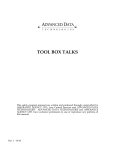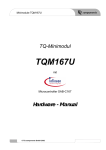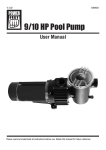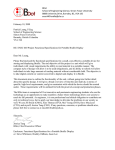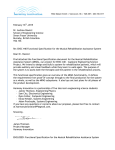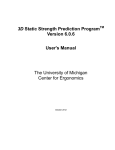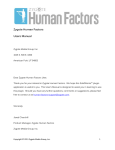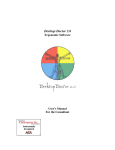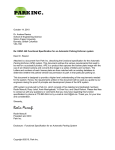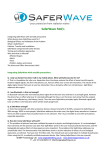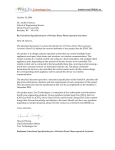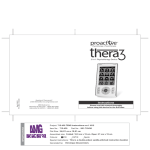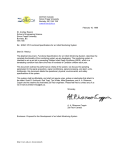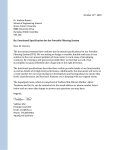Download Example Functional Spec
Transcript
School of Engineering Science Simon Fraser University Burnaby, BC V5A 1S6 [email protected] October 18, 2005 Dr. Andrew Rawicz School of Engineering Science Simon Fraser University Burnaby, British Columbia V5A 1S6 Re: ENSC 340 Functional Specification for the Auto-Conforming Ergonomic Chair Dear Dr. Rawicz: Attached is a document from Accomodarsi Solutions describing the functional specification for the Auto-Conforming Ergonomic (ACE) Chair. We are designing and implementing an office task chair that will sense the dimensions of each user and then automatically adjust to provide optimal support and comfort. The ACE Chair will remove the possibility of the user forgetting to adjust their chair and take away the frustration that comes with the manual adjustment process. Our functional specification provides a set of high-level requirements for the system’s functionality for both the proof-of-concept and production phases of development. Our project manager and design engineers will use this document as a guide for research and development activities. Accomodarsi Solutions is comprised of six students: Jennard Dy, Stephanie Fung, Eric Lee and Eric Leung from SFU Engineering, Daphne Leung from SFU Kinesiology, and Russell Booth, an Industrial Design student at the Emily Carr Institute. If you have any questions or comments, please contact us by email at [email protected]. Alternatively, you may contact me by phone at (778) 855-5940. Sincerely, Stephanie Fung Stephanie Fung Chief Executive Officer Accomodarsi Solutions Enclosure: Functional Specification for an Auto-Conforming Ergonomic Chair Copyright © 2005, Accomodarsi Solutions Functional Specification for the Auto-Conforming Ergonomic Chair Project Team: Jennard Dy Stephanie Fung Eric Lee Eric Leung Russell Booth Daphne Leung Contact Person: Jennard Dy [email protected] Submitted to: Dr. Andrew Rawicz – ENSC 340 Mike Sjoerdsma – ENSC 305 Brad Oldham Steve Whitmore School of Engineering Science Simon Fraser University Date: October 18, 2005 Revision: 1.8 Copyright © 2005, Accomodarsi Solutions Functional Specification for the Auto-Conforming Ergonomic Chair Executive Summary The modern desk job requires an employee to be seated for the majority of their workday, which could mean upwards of 7 hours per day sitting in an office chair. Long hours spent seated in a chair puts users at increasingly higher risks for back pain and other workrelated musculoskeletal disorders. Although employers have been proactively purchasing comfortable adjustable chairs in an effort to alleviate their employees’ discomfort, it is often the unfortunate case that these chairs are not adjusted properly, or sometimes not adjusted at all. The Auto-Conforming Ergonomic (ACE) Chair seeks to give the user the full benefit of their adjustable chair by automatically adjusting as soon as the user sits down, ensuring that the adjustment process is not forgotten or performed incorrectly. Development of the ACE Chair will occur in two phases. Upon completion of the first phase, the chair will support automatic adjustment of the following dimensions: • armrest height, • horizontal distance between armrests, • vertical position and size of the lumbar support, • amount of lateral support on the backrest, and • seat depth. The adjustment ranges are chosen to accommodate more than 90% of the normal adult population [1]. In addition, the user will be able to manually fine-tune the automatic adjustments through an easy-to-use interface. The four-month development cycle of this prototype phase is targeted for completion on December 12, 2005. For the second phase of development, the ACE Chair will also be capable of automatically adjusting the seat contour, seat tilt angle, and backrest angle. The chair will include a fully adjustable headrest and a variety of functions to enhance comfort. By the end of this development phase, the ACE Chair will no longer be dependent on the power supplied by an electrical outlet and instead will contain a portable self-sufficient power source that can operate for a week between charges. Furthermore, the ACE Chair will conform to all pertinent standards and guidelines, including those of the CSA and BIFMA. Copyright © 2005, Accomodarsi Solutions ii Functional Specification for the Auto-Conforming Ergonomic Chair Table of Contents Executive Summary ............................................................................................................ ii List of Figures .................................................................................................................... iv Glossary ............................................................................................................................. iv 1 Introduction................................................................................................................. 1 1.1 Scope................................................................................................................... 1 1.2 Intended Audience .............................................................................................. 1 1.3 Classification....................................................................................................... 1 2 System Requirements.................................................................................................. 2 2.1 System Overview ................................................................................................ 2 2.2 General Requirements......................................................................................... 4 2.3 Physical Requirements........................................................................................ 5 2.4 Electrical Requirements ...................................................................................... 5 2.5 Mechanical Requirements................................................................................... 5 2.6 Environmental Requirements.............................................................................. 5 2.7 Standards............................................................................................................. 6 2.8 Reliability and Durability ................................................................................... 6 2.9 Safety Requirements ........................................................................................... 6 2.10 Performance Requirements................................................................................. 7 2.11 Usability Requirements....................................................................................... 7 2.12 Luxury Functions ................................................................................................ 7 3 Armrests...................................................................................................................... 8 3.1 General Requirements......................................................................................... 8 3.2 Physical Requirements........................................................................................ 9 4 Seat.............................................................................................................................. 9 4.1 General Requirements......................................................................................... 9 4.2 Physical Requirements...................................................................................... 10 5 Backrest..................................................................................................................... 10 5.1 General Requirements....................................................................................... 10 5.2 Physical Requirements...................................................................................... 10 6 Headrest .................................................................................................................... 10 7 User Interface Unit.................................................................................................... 11 7.1 General Requirements....................................................................................... 11 7.2 Usability Requirements..................................................................................... 11 7.3 Physical Requirements...................................................................................... 11 8 User Documentation ................................................................................................. 11 9 System Test Plan....................................................................................................... 13 10 Conclusion ............................................................................................................... 15 11 References................................................................................................................ 16 Copyright © 2005, Accomodarsi Solutions iii Functional Specification for the Auto-Conforming Ergonomic Chair List of Figures Figure 1: High-Level Functional Block Diagram............................................................... 2 Figure 2: Chair Adjustment Guidelines (Image Courtesy of CSA) [7] .............................. 4 Glossary ANSI American National Standards Institute BIFMA Business and Institutional Furniture Manufacturer’s Association CGSB Canadian General Standards Board CSA Canadian Standards Association Ergonomic Exhibiting good design so as to maximize productivity by reducing fatigue and discomfort [2]. Kyphosis Lordosis Waterfall Edge A rounded “c” shaped spine position [6]. An “s” shaped spine position [6]. The rounded shape of the front edge of the seat, designed to relieve pressure from the back of the knees. Work-Related Musculoskeletal Disorder (WMSD) An injury or illness to soft tissues such as muscles, nerves, tendons, ligaments, joints, cartilage, and spinal disks. Generally developing gradually over a period of time, they are primarily caused by sustained and repeated exertions or awkward postures and manipulations [3]. An adult user with the following characteristics: • no back ailments and/or physical disabilities that affects sitting • height between 52 cm and 194 cm • weight between 45 kg and 115 kg • has body dimensions that fall between those of the 5th percentile female and the 95th percentile male [1][4] The user is seated in an ergonomic position for the task at hand. ACE Chair User Comfortable Copyright © 2005, Accomodarsi Solutions iv Functional Specification for the Auto-Conforming Ergonomic Chair 1 Introduction The Auto-Conforming Ergonomic (ACE) Chair is an office chair that will adjust itself to comfortably support anyone that sits in it. By sensing the position of the seated user, the ACE Chair can intelligently adjust the backrest, seat, and armrests to provide the user with unparalleled ergonomic support and seating comfort. The requirements for the ACE Chair, as proposed by Accomodarsi Solutions, are described in this functional specification. 1.1 Scope This document describes the functional requirements that must be met by a functioning ACE Chair. This set of requirements fully describes the proof-of-concept device and partially describes the production device. The listed requirements will drive the design of the ACE Chair and will be traceable in future design documents. 1.2 Intended Audience The functional specification is intended for use by all members of Accomodarsi Solutions. The project manager shall refer to the functional requirements as a concrete measure of progress throughout the development phase. Design engineers shall refer to the requirements as overall design goals to be kept in mind from product design through to implementation. Test engineers shall use this document to assist in assessing the similarity of function in the actual system with the functionality described in this document. Ergonomists shall use this document to aid in the design of user test trials. 1.3 Classification Throughout this document, the following convention shall be used to denote functional requirements: [Rn-p] A functional requirement. where n is the functional requirement number, and p is the priority of the functional requirement as denoted by one of three values: I II III The requirement applies to the proof-of-concept system only. The requirement applies to both the proof-of-concept system and the final production system. The requirement applies to the final production system only. Copyright © 2005, Accomodarsi Solutions 1 Functional Specification for the Auto-Conforming Ergonomic Chair 2 System Requirements General requirements applicable to the ACE Chair as a complete system are presented in this section. 2.1 System Overview The ACE Chair is a system that can be modeled at a high-level as shown in Figure 1. Figure 1: High-Level Functional Block Diagram Due to time and budget constraints in the first stage of development, only selected parts of the chair will adjust automatically. These parts are the armrests, backrest, and seat depth. The armrest height and the horizontal clearance between armrests will adjust electronically to suit the position of the forearms. On the backrest, a lumbar support will conform to the size and position of the user’s lumbar curve. Lateral supports on the sides of the backrest will also adjust to offer additional support to the user’s back. The seat depth will adjust to accommodate the length of the user’s thigh. All parts that can move automatically can also be manually adjusted using an electronic user interface. One important aspect of the chair that will not move automatically is the seat height. This adjustment will be operated manually using a standard lever control for the following reasons: • Seat height is not a commonly overlooked adjustment. • The correct seat height depends on external factors such as desk height [5]. • Adjusting the seat height automatically requires overcoming the user’s weight. The chair must accommodate the ACE Chair User as defined in the glossary, henceforth referred to as the User. The User is assumed to be sitting in the proper position and with the proper posture before adjustment begins. As suggested by our Ergonomics Consultant, the proper seating position is described as follows: The User will sit on the chair with his or her arms at their sides, with the forearms forming an approximately 90-degree angle with their upper arms. He or she must also sit with the spine having a slight lumbar lordosis. The User must also leave some space between the back of the knees and the front edge of the seat so no pressure is felt behind the knees. This space shall be no greater than the width of a fist placed between the chair and the back of the knees. Copyright © 2005, Accomodarsi Solutions 2 Functional Specification for the Auto-Conforming Ergonomic Chair When ready, the User will indicate to the chair that they have correctly adjusted the seat height and are seated properly; the adjustments will then begin. The armrests will move until the sensors on the armrests determine that the User’s arms are resting on the armrests. The backrest will also move forward to support the User’s back. The lumbar and side supports will adjust until the sensors sense that they adequately fit the User’s lumbar area and sides of the torso. The automatic adjustments (armrests, seat depth and lumbar support) will conform to the ranges of motion shown in Figure 2. In the production device, all movable parts of the chair, both automatic and manual, will conform to the guidelines shown in Figure 2. Note that our prototype device will not have all the functionalities depicted in Figure 2. After the production phase is complete, the chair will have modes for different tasks such as working and relaxing. The chair will also feature other functions as defined in the “Luxury Functions” section. Copyright © 2005, Accomodarsi Solutions 3 Functional Specification for the Auto-Conforming Ergonomic Chair Figure 2: Chair Adjustment Guidelines (Image Courtesy of CSA) [6] 2.2 General Requirements [R1-II] [R2-III] [R3-III] The chair shall have an idle state where all adjustable parts are locked and static. The retail price of the chair shall be under CDN$2000. Sensors and actuators shall be minimally intrusive to the user. Copyright © 2005, Accomodarsi Solutions 4 Functional Specification for the Auto-Conforming Ergonomic Chair 2.3 Physical Requirements [R4-I] [R5-II] [R6-II] [R7-II] [R8-III] The height of the chair (without headrest) shall not exceed 125 cm. The base diameter shall be no larger than 80 cm. The chair shall be similar in appearance to a regular office chair. The chair shall look sexy. The height of the chair (with headrest) shall not exceed 155 cm. 2.4 Electrical Requirements [R9-II] [R10-II] [R11-II] [R12-II] [R13-II] [R14-II] [R15-III] [R16-III] [R17-III] The power supply shall be sufficient to support the simultaneous movement of all automatically adjustable parts. The power adapter shall be usable with a wall supply of 110V/120V at 60 Hz AC, which is typical of North American wall outlets. The attached cord for the power adaptor shall have a length no less than 3 m. The power cord shall be easily stowed in the chair. The chair shall enter a state of energy conservation after 30 minutes of inactivity. Key voltage nodes shall be easily accessible for measurement, troubleshooting, and debugging. A portable self-sufficient power source may be used instead of the power adaptor and shall last for a week between charges, based on a complete readjustment every 2 hours. The portable self-sufficient power source shall be easily accessible for replacement. The portable self-sufficient power source shall be operational for at least 5 years before requiring replacement. 2.5 Mechanical Requirements [R18-II] [R19-II] [R20-III] [R21-III] All parts that are not automatically adjustable can only be moved through levers, knobs, or other pre-existing mechanisms. All parts that are automatically adjustable can be moved manually using the electronic user interface. The chair shall have user-centered tilting (the backrest and seat tilt back as a single unit when the user leans back). The mechanical components of the chair shall not be visually or physically obtrusive. 2.6 Environmental Requirements [R22-II] [R23-II] The chair shall operate normally within an elevation range from sea level to 2000 m above sea level. The chair shall operate normally under typical office temperatures (15 – Copyright © 2005, Accomodarsi Solutions 5 Functional Specification for the Auto-Conforming Ergonomic Chair [R24-II] [R25-II] [R26-II] [R27-II] [R28-III] 30°C) [8]. The chair shall operate normally under typical office humidity conditions (50%) [8]. The chair must be used indoors only. The chair shall be silent when it is inactive. Noise generated during periods of activity shall be minimized. Noise generated during periods of activity shall be below 50 dB. 2.7 Standards [R29-III] [R30-III] [R31-III] [R32-III] The chair shall conform to CGSB-44.232-2002 standards [9]. The chair shall conform to ANSI standards. The chair shall meet CSA requirement CSA-ISO 9241-5-00 [10]. The chair shall conform to BIFMA standards. 2.8 Reliability and Durability [R33-II] [R34-II] [R35-II] [R36-III] [R37-III] [R38-III] [R39-III] [R40-III] [R41-III] The chair shall be able to withstand day-to-day physical treatment. The user interface shall be resistant to breakage under normal operating conditions. The chair shall be serviceable by trained technicians. The chair shall be resistant to electronic and mechanical damage caused by spills on the chair. The chair shall be able to remain on for at least 3 days when running on the portable self-sufficient power source. The chair shall be able to continuously adjust for 3 hours. The MTBF (mean time between failures) of the chair shall be no less than 20,000 hours. Regular service intervals shall be at least yearly. All the device interfaces shall have a duty cycle of at least 1,000,000 cycles. 2.9 Safety Requirements [R42-II] [R43-II] [R44-III] [R45-III] [R46-III] [R47-III] The chair shall not cause bodily harm to the user while the chair is adjusting. The chair shall not spontaneously combust. The chair shall be able to detect improper use (kneeling or standing on it) and cease automatic adjustment. The electronic and mechanical components and power connections shall be enclosed. The electronic components of the chair shall not cause interference with other devices. The chair will be able to detect mechanical and electrical failure. If any error is detected, the chair shall notify the user that an error has occurred. In the Copyright © 2005, Accomodarsi Solutions 6 Functional Specification for the Auto-Conforming Ergonomic Chair [R48-III] error mode, the chair will not make any movements and will not respond to any user input except the off switch. Upon start-up the chair will run through a diagnostic routine to check that the chair is safe for operation. After powering on, if the chair detects a previous failure that has not been fixed, it will remain in an error state. 2.10 Performance Requirements [R49-II] [R50-II] [R51-II] [R52-III] The chair shall respond to manual adjustment user input within 500 ms. The chair shall indicate that it is on within 500 ms after activation. The total time taken to perform automatic adjustments shall not exceed 5 minutes. The chair shall respond to mode changes within 1 s. 2.11 Usability Requirements [R53-II] [R54-II] [R55-II] [R56-II] [R57-II] [R58-III] The chair shall perform adjustments assuming that the user has first correctly adjusted the seat height. The chair shall perform adjustments assuming that the user is sitting correctly in the seat. The chair shall not exceed 50 kg in order to be light enough for the seated user to move the chair around on an indoor, smooth, non-carpeted surface. The heat output from the operating chair shall not affect the comfort of the seating surfaces. The chair’s firmware shall be upgradeable by a service person. The chair shall have an interface for external connection with a PC for diagnostic purposes. 2.12 Luxury Functions [R59-III] [R60-III] [R61-III] [R62-III] [R63-III] [R64-III] The seat and backrest shall be temperature-controlled to heat up or cool down the chair surfaces in contact with the user by ±5 °C with respect to current room temperature. The chair shall warn the user if it determines that he or she has been sitting for a prolonged period of time. The chair shall be equipped with cup holders. The chair shall remember and revert to a user’s preferences upon verifying their identity. The chair shall have a massage feature whereby the lumbar support moves vertically in a defined pattern. The chair shall have an “auto-follow” feature whereby the chair makes subtle adjustments in response to minor, infrequent shifting of the user on the chair, in order to reduce strain caused by prolonged seating in one position. If the Copyright © 2005, Accomodarsi Solutions 7 Functional Specification for the Auto-Conforming Ergonomic Chair User makes a significant change to his or her posture, the chair will remain stationary. 3 Armrests Armrests serve several important functions, including the following: • to provide support to the muscles of the neck and shoulders, • to provide an opportunity for rest when work is interrupted, • to aid the user when standing up and sitting down, and • to reduce the static loading of the shoulder and upper arm muscles in users who work intensively with a mouse [6]. To prevent unnecessary strain to the arms and shoulders, it is therefore important that armrests are adjusted correctly to fit the user. The requirements listed in the following subsections refer to terms that will now be defined. Armrest height is measured from the top of the armrest to the top of the compressed seat. Armrest width is the inside horizontal distance between armrests. Armrest width is an important dimension for two reasons: 1. to ensure the hips clear the armrests when getting in and out of the chair while seated, and 2. to ensure that the armrest offers a comfortable resting place for the arms without being too close or too far apart. The following requirements for the seat reflect the guidelines prescribed by CSA International [6]. 3.1 General Requirements [R65-II] [R66-II] [R67-II] [R68-II] [R69-II] The height of the armrests shall be automatically adjustable with a range of at least 50 mm, including the range from 176 – 274 mm. The lockable height increments shall be no greater than 13 mm. The inside distance between the armrests shall be automatically adjustable with a range of at least 50 mm and shall not be less than 450 mm. The armrests shall automatically adjust so that the upper arms are resting comfortably by the user’s sides. The armrests shall adjust in tandem, as if they were mirror images of each other. The user will not be able to manually adjust the armrests to be at different heights. Copyright © 2005, Accomodarsi Solutions 8 Functional Specification for the Auto-Conforming Ergonomic Chair [R70-II] [R71-II] [R72-III] [R73-III] [R74-III] The armrests shall extend far back enough to provide adequate forearm support even when the user is leaning back. The armrests shall remain parallel to the ground. The armrests shall move forward and backward (“setback”) + 100 mm. The armrests shall be able to rotate laterally a minimum of 20º inwards and a minimum of 10º outwards. The armrests shall automatically adjust so that the forearms apply an even pressure on both ends of the armrest. 3.2 Physical Requirements [R75-II] [R76-II] [R77-II] [R78-II] [R79-III] The width of the armrest cap shall be at least 45 mm. The length of the armrest shall be between 130 – 180 mm. The armrests shall be set back at least 150 mm from the front edge of the seat. The armrests shall provide comfortable padded support for the forearms. The armrests shall be removable. 4 Seat Seat depth is defined as the maximum depth from the seat front to backrest. Correct adjustment of this dimension is important to ensure that: • the legs can be positioned so there is no compression at the back of the knee, and • the buttocks can be positioned to enable full use of the backrest [6]. A variable seat angle allows the user to vary their posture forward and backward. This dimension is largely a user preference, so its implementation will begin in the production phase. The following requirements for the seat reflect the guidelines prescribed by CSA International [6]. 4.1 General Requirements [R80-II] [R81-II] [R82-III] [R83-III] The seat depth shall be automatically adjustable by at least 50 mm and shall include the range from 420 – 460 mm. The seat height shall be manually adjustable by the user within the range of 380 – 510 mm. The seat pan angle shall be adjustable to a minimum of 3º forward and 4º rearward from the horizontal position. The seat firmness shall be automatically adjustable. Copyright © 2005, Accomodarsi Solutions 9 Functional Specification for the Auto-Conforming Ergonomic Chair 4.2 Physical Requirements [R84-II] [R85-II] The seat shall have a waterfall edge as specified in the CGSB Standards [9]. The seat width shall be at least 450 mm wide. 5 Backrest The backrest’s primary function is to evenly distribute the pressure from the User’s back across the surface of the backrest. The backrest will have adjustable contours in the lumbar region to support the unique spinal curve of each individual. The pair of supports running vertically down the sides of the backrest will support the lateral part of the user’s back, further distributing loads evenly across the backrest. The requirements in the following subsections reflect the guidelines prescribed by CSA International [6]. 5.1 General Requirements [R86-II] [R87-II] [R88-II] [R89-II] [R90-III] [R91-III] The shape of the lumbar support shall automatically change to conform to the shape of the user’s lumbar region. The size of the lateral supports shall adjust to fit different body sizes. The vertical position of the lumbar support shall be automatically adjustable to a range of 50 mm within the interval of 150 – 250 mm above the seat. The vertical distance between the bottom of the backrest and the top of the seat pan shall be large enough to accommodate the User’s buttocks. The backrest angle shall be adjustable a minimum of 10º within a range of 93º to 113º from the horizontal. The backrest tilt mechanism shall allow the backrest to tilt backward when activated with a load, and allow the backrest to return to the forward position with the load removed. 5.2 Physical Requirements [R92-II] [R93-II] The backrest cushion shall be at least 350 mm wide. The top of the backrest cushion shall be between 450 and 550 mm above the seat surface. 6 Headrest Development of the headrest shall begin after the proof-of-concept product is complete. Copyright © 2005, Accomodarsi Solutions 10 Functional Specification for the Auto-Conforming Ergonomic Chair [R94-III] The chair shall have a height and depth-adjustable headrest. 7 User Interface Unit The user interface unit shall consist of a set of buttons as inputs, which will be connected to the processing unit. The user interface shall also include display elements as outputs. These outputs shall be driven by the outputs from the processing unit. 7.1 General Requirements [R95-II] [R96-II] [R97-II] [R98-III] [R99-III] The primary means of user input shall be through a set of push buttons and switches. The user interface unit shall have a power off switch. The outputs on the user interface unit shall consist of status indicators to indicate power on, “busy”, and manual control. The outputs on the user interface unit shall consist of status indicators to indicate low battery and “trouble”. The user interface unit shall allow the user to select various customizations including but not limited to: working mode, relaxed mode, typing mode, and sleeping mode. 7.2 Usability Requirements [R100-II] The user shall indicate through the user interface unit when they are ready for the chair to make automatic adjustments. [R101-II] The manual adjustment interface shall be intuitive and easy-to-use. 7.3 Physical Requirements [R102-II] [R103-II] [R104-III] The control panel shall be easily accessible to the seated user. The control panel shall be placed so that it is difficult to press buttons unintentionally. The control panel shall be placed in the armrest. 8 User Documentation [R105-III] [R106-III] User documentation shall include a website with general and technical support information and a user manual, both written in English. The user manual shall be written for an audience with minimal knowledge Copyright © 2005, Accomodarsi Solutions 11 Functional Specification for the Auto-Conforming Ergonomic Chair [R107-III] [R108-III] of electromechanical devices and ergonomics. User documentation shall be provided in French, Spanish, German, Traditional Chinese, Simplified Chinese, and Japanese to satisfy product language requirements for international markets. A detailed installation guide for technicians and vendors shall be created. Copyright © 2005, Accomodarsi Solutions 12 Functional Specification for the Auto-Conforming Ergonomic Chair 9 System Test Plan The general approach to system testing consists of separately testing the individual modules comprising the ACE Chair, testing groups of combined modules, and finally testing the complete unit. Once development of the proof-of-concept has reached the final stages, our Ergonomic Consultant will conduct detailed user trials of the chair. Testing procedures will be discussed to varying degrees with an emphasis on the requirements of the proof-of-concept version. More specific testing procedures will be developed during the design and implementation stages. There are many requirements on the physical dimensions of the entire chair and on the various parts of the chair. These will be verified in the design drawings of the parts and of the complete chair. Once the chair has been assembled, the requirements will be verified by measuring the dimensions of the chair and the individual parts. All adjustable parts have functional requirements dictating a minimum range of actuation (i.e. length of motion or angle of rotation). These requirements will be tested during the construction of the individual parts of the chair and again after the entire system has been assembled. Each procedure will vary according to the specific part being tested, but the general testing methodology is to manually move the part to the extreme positions and measure the range of motion. After the manual tests are complete, those parts with automatic adjustment capabilities will undergo further testing. Inputs to the control system will be provided so as to elicit the maximal range of automatic adjustment. The maximal range of automatic adjustment will be compared and verified with the maximal range of manual adjustment and the minimum required range of actuation. To confirm that the power supply is sufficient to move all automatically adjustable parts simultaneously, a test program will be created which attempts to activate all the parts simultaneously. With all parts moving, the power drawn will be measured and compared with the rating of the power supply. After the parts have been moving continuously in excess of 2 minutes, visual inspections will be performed to confirm the system’s operation and to verify that the operating temperature of the various components are within safe limits. In the production stage, the portable power source will be fully charged then run down by making a complete readjustment every 2 hours until the power source fails. Typical Usage Scenario: Designed to mimic the intended use of the product, the typical usage scenario describes the steps a User would go through to use the ACE Chair. 1. User sits down properly on the ACE chair. 2. If seat height is wrong, User manually adjusts the seat height by using the lever under the seat pan. Copyright © 2005, Accomodarsi Solutions 13 Functional Specification for the Auto-Conforming Ergonomic Chair 3. While seated properly with arms at a 90-degree position, User activates the automatic adjustment sequence. 4. The ACE Chair adjusts to fit the User’s dimensions. To test the performance requirements and overall suitability of the adjusted positions, test subjects with varying body shapes and sizes will be put through the typical usage scenario outlined above. After the ACE Chair has finished adjusting, our Ergonomics Consultant will analyze the resulting chair configuration and verify that the chair is optimally supporting the test subject in the position in which they are sitting. If significant differences are found between the Ergonomics Consultant’s recommended chair configuration and the ACE Chair’s automatic configuration, the adjustment algorithm will be improved and the performance requirements retested. Total adjustment time will be measured using a digital watch or similar timepiece. The Ergonomics Consultant will also conduct additional testing on user comfort, usability, and satisfaction. The functional specifications also include requirements for operational safety and error handling. To test these requirements, the error conditions will be simulated and the system response verified (the adjustment should stop immediately). To keep these tests as non-destructive and painless as possible, the error conditions will only be present for a short time. Initial tests will be conducted using solid objects in place of body parts. Both manual adjustments through the user interface and automatic adjustments will be interrupted by placing the foreign object in a dangerous position while the chair is adjusting, then observing the time to stop the adjustment once contact is made with the object. The object will be visually inspected for any pinch marks. Copyright © 2005, Accomodarsi Solutions 14 Functional Specification for the Auto-Conforming Ergonomic Chair 10 Conclusion The functional specification clearly defines the capabilities and requirements of the ACE Chair. Development of the final production device will take place in two distinct phases. The proof-of-concept model is well underway and it is confidently expected that all functional requirements outlined above applying to the proof-of-concept model (marked with I or II) will be completed by the target date of December 12, 2005. Copyright © 2005, Accomodarsi Solutions 15 Functional Specification for the Auto-Conforming Ergonomic Chair 11 References [1] Pheasant, Stephen, Bodyspace: Anthropometry, Ergonomics and the Design of Work, 2nd Edition. Great Britain: Taylor & Francis, 1996. [2] Dictionary.com, Dictionary entry for “ergonomic”, 2005. [Online]. Available: http://dictionary.reference.com/search?q=ergonomic. [Accessed: September 17, 2005]. [3] Assemblymag.com, News: Lean Workstations: Glossary of Ergonomics Terms, February 10, 2005. [Online]. Available: http://www.assemblymag.com/CDA/ ArticleInformation/news/news_item/0,6501,144249,00.html. [Accessed: September 17, 2005]. [4] Microsphere.com, Freedom Chair Infosheet, 2005. [Online]. Available: http://www.microsphere.com/pdf/freedomchair-infosheet.pdf. [Accessed: October 16, 2005]. [5] Leung, Daphne, Conversation with group members, October 9, 2005. [6] Steelcase, Ergonomics – Seating – Supporting Natural Human Motion While Seated, 2005. [Online]. Available: http://www.steelcase.com/na/knowledgedesign.aspx?f=10260&c=10985. [Accessed October 16, 2005]. [7] Canadian Standards Association International, CSA Z412 – Guideline on Office Ergonomics. Rexdale: Canadian Standards Association, 2000. [8] Canadian Centre for Occupational Health and Safety, “What is meant by thermal comfort?”, OSH Answers: Thermal Comfort for Office Work, August 23, 2005. [Online]. Available: http://www.ccohs.ca/oshanswers/phys_agents/thermal_comfort.html. [Accessed: October 16, 2005]. [9] Canadian General Standards Board, CGSB-44.232-2002 – Task Chairs For Office Work With Visual Display Terminals. Ottawa: Canadian General Standards Board, 2002. [10] Canadian Standards Association International, CSA-ISO 9241-5-00 – Ergonomic Requirements For Office Work With Visual Display Terminals. Standards Council of Canada: 2000. Copyright © 2005, Accomodarsi Solutions 16





















